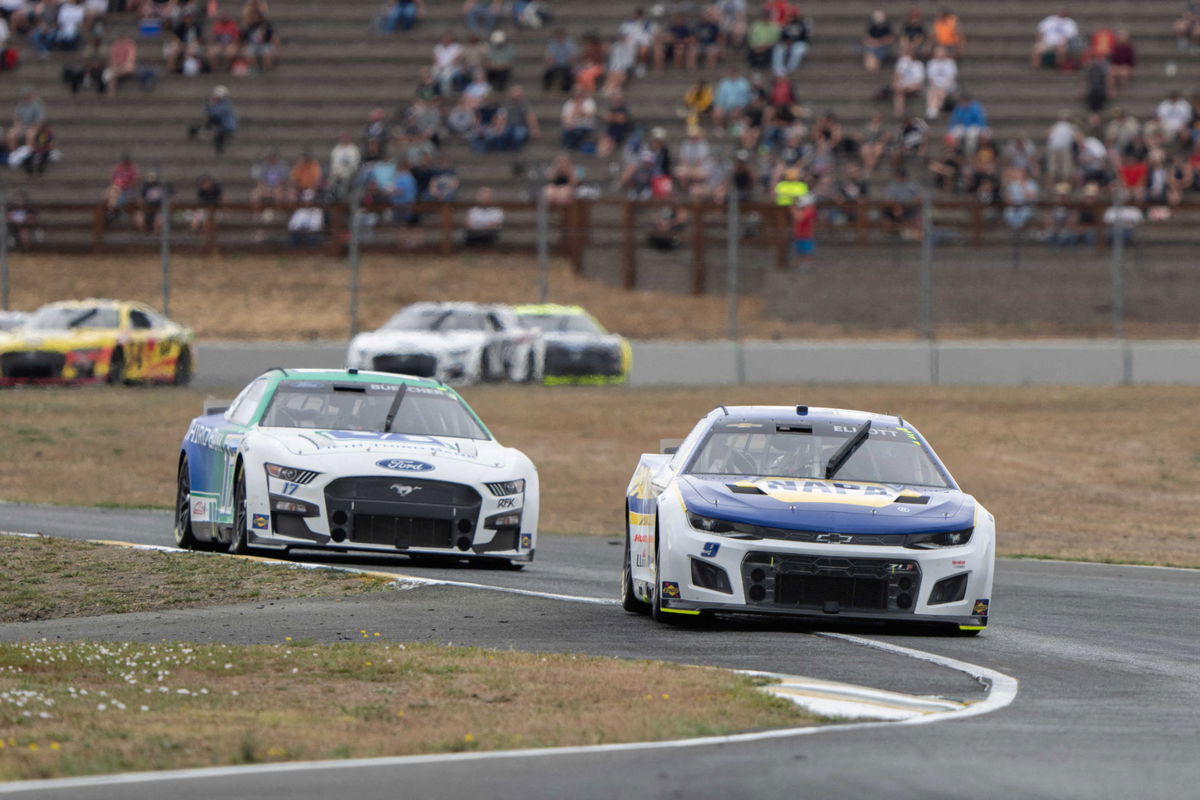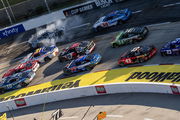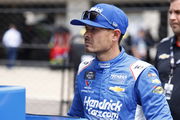
USA Today via Reuters
Jun 12, 2022; Sonoma, California, USA; NASCAR Cup Series driver Chase Elliott (9) leads the group during the NASCAR Toyota – Save Mart 350 event at Sonoma Raceway. Mandatory Credit: Stan Szeto-USA TODAY Sports

USA Today via Reuters
Jun 12, 2022; Sonoma, California, USA; NASCAR Cup Series driver Chase Elliott (9) leads the group during the NASCAR Toyota – Save Mart 350 event at Sonoma Raceway. Mandatory Credit: Stan Szeto-USA TODAY Sports
The definition of the word “cheating” is as ambiguous as it gets on the tracks of NASCAR. Every team in the sport pushes as hard as they can to get that win at the end of the day. This does not translate to just pushing the boundaries of the drivers and cars but also (mis)interpreting the rule book. Winning in NASCAR has on occasion meant how far someone can bend the rules without snapping them, or blanket them in the name of “innovation.”
Watch What’s Trending Now!
One of the most infamous outlooks on cheating in NASCAR came from Darrell Waltrip after his own “nitrous oxide” scandal in 1976. He said, “If you don’t cheat, you look like an idiot. If you do it and you don’t get caught, you look like a hero. If you do it and get caught, you look like a dope. Put me in the category where I belong.” With the words of Waltrip in hindsight, let’s take a look at 5 instances when drivers cheated and loved it.
ADVERTISEMENT
1. Marty Robbins, Talladega, 1972
Marty Robbins is widely acclaimed as one of the greatest country singers of his era. But he also was a great racer. Apart from local circuits, he participated in 35 Cup racers over his career. One funny yet brutally honest incident that involved Martin came back in 1972. Racing in Talladega, he drove laps 15 mph faster than anyone else on the grid and took the win for himself. But when he was given the Rookie of the Race Award, he turned it down to the surprise of everybody.
Admitting then that he had illegally put holes in his restrictor plate, he revealed the cause for his extra speed. He explained his innocent desire, saying, “Just wanted to see what it was like to run up front for once.”
Top Stories
Controversial Crew Chief Finds Fresh Start With 17-Yo NASCAR Team

NASCAR Team Owner Demands Charter-Like Deal for Financially Struggling O’Reilly Series

Footage Surfaces of Florida Police Arresting NASCAR Veteran Over Disturbing Public Misbehavior

Ex-Fox Broadcaster Publicly Exposes One of His Own Amidst Denny Hamlin’s Ugly Social Media Feud

Kyle Larson’s Sprint Car Rivals Threatens Criminal Action Against Track Owner Over $15,000 Winner’s Purse

ADVERTISEMENT
2. Smokey Yunick’s fuel line, 1968
Smokey Yunick is credited with saying, “There are two types of racers—cheaters and losers.” Yunick was an everlasting thorn in the sides of NASCAR officials. Using his brilliant engineering mind, he was always at work to bypass the rule book that the promotion had to keep changing because of him. A genius of aerodynamic techniques, he pulled several tricks that helped him interpret the rule book distinctly.
An example of ingenuity was when NASCAR specified the size of fuel tanks. Post the implementation of the rule, Yunick kept getting extraordinarily additional mileage in his car. Upon inspection, it came to light that his fuel tank was the specified size. But his fuel line wasn’t standard. Yunick had devised a two-inch line that was 11 feet long. It could hold five gallons of gas in it.
ADVERTISEMENT
ADVERTISEMENT
There are several such stories involving him. Some could just be fables while some have been verified by many insiders. End of the day, Yunick was a brilliant engineer who was proud of his tricks though they didn’t get the nod of NASCAR.
3. Dale Earnhardt Jr, Bristol, 2004
The most popular NASCAR driver of this century, Dale Earnhardt Jr, once caused an intentional spin fearing a losing lap owing to a lug nut problem. Driving at the Bristol Motor Speedway, he was cruising through the 430th lap when a lug nut issue caused him to spin and bring out a caution. Moments later, Junior told his crew chief that he’d caused the spin on purpose. He also joked about it in the post-race interview without understanding the consequences of his action.
ADVERTISEMENT
Then NASCAR President Mike Helton said before handing out a fine of $10,000, “The driver of the #8 car was quite vocal in admitting he intentionally spun out his car to cause a caution condition on the track, which is clearly prohibited in the NASCAR Rule Book.” Teresa Earnhardt, Junior’s stepmother and the owner of DEI, later said, “In the heat of battle, a lot of things can happen and decisions can be made that come at a high cost.” Junior was also relieved of 25 points in the aftermath of his action.
4. Junior Johnson, Yellow Banana, 1966
“I loved the game. Maybe I’d have four of five new things on a car that might raise a question. But I’d always leave something that was outside of the regulations in a place where the inspectors could easily find it. They’d tell me it was illegal, I’d plead guilty, and they’d carry it away thinking they caught me. But they didn’t check some other things that I thought were even more special.” These words from Junior Johnson sum up the attitude that he faced NASCAR’s regulations with. The best of his “creations” came in Atlanta in 1966 when he rolled up into the tracks with the oddest looking car in the sport.
ADVERTISEMENT
Poised with a chopped roofline and a slanted windshield amongst other changes that were aimed at improving aerodynamics, his modified Ford Galaxie was nicknamed the “Yellow Banana.” Owing to the ongoing tensions with Ford over stringent engine regulations, NASCAR turned its head and allowed the car to race despite its illegality. In 1967, NASCAR came up with its new body template rules.
Junior Johnson’s 1966 yellow banana is known as one of the most infamously cheated cars in @NASCAR history. I’ve always loved the iconic look of it and can’t wait to honor the creativity of early stock car builders at @TooToughToTame next weekend! 🍌 #NGROTS #NASCAR pic.twitter.com/fu24jy5GN6
— Tyler Ankrum (@TylerAnkrum) August 30, 2020
ADVERTISEMENT
5. Darrell Waltrip, Daytona 500, 1976
In the 1976 Daytona 500, Darrell Waltrip qualified for the race at blistering speed and was among the clear favorites for the win. However, things quickly turned downhill when he was discovered using illegal nitrous oxide substances to pump the horsepower of his car. A.J. Foyt and Dave Marcis did the same with their cars as well.
All three drivers were disqualified from participating in the race. Waltrip, however, owned up to the cheat saying, “If you don’t cheat, you look like an idiot. If you do it and you don’t get caught, you look like a hero. If you do it and get caught, you look like a dope. Put me in the category where I belong.”
The rulebook and the methods of rule-breaking have always been an active and hot topic in NASCAR ever since the 1950s. Perhaps the character of the sport is embodied in the eagerness of teams, crews and drivers to figure out ways to read between the lines of the book. In the words of former NASCAR Chairman Bill France Jr, “Someone always will figure out how to get around the rules, even though we try to make them as clear as possible. Lawyers and accountants have been doing that with the tax code for years.”
ADVERTISEMENT
ADVERTISEMENT
ADVERTISEMENT
ADVERTISEMENT

